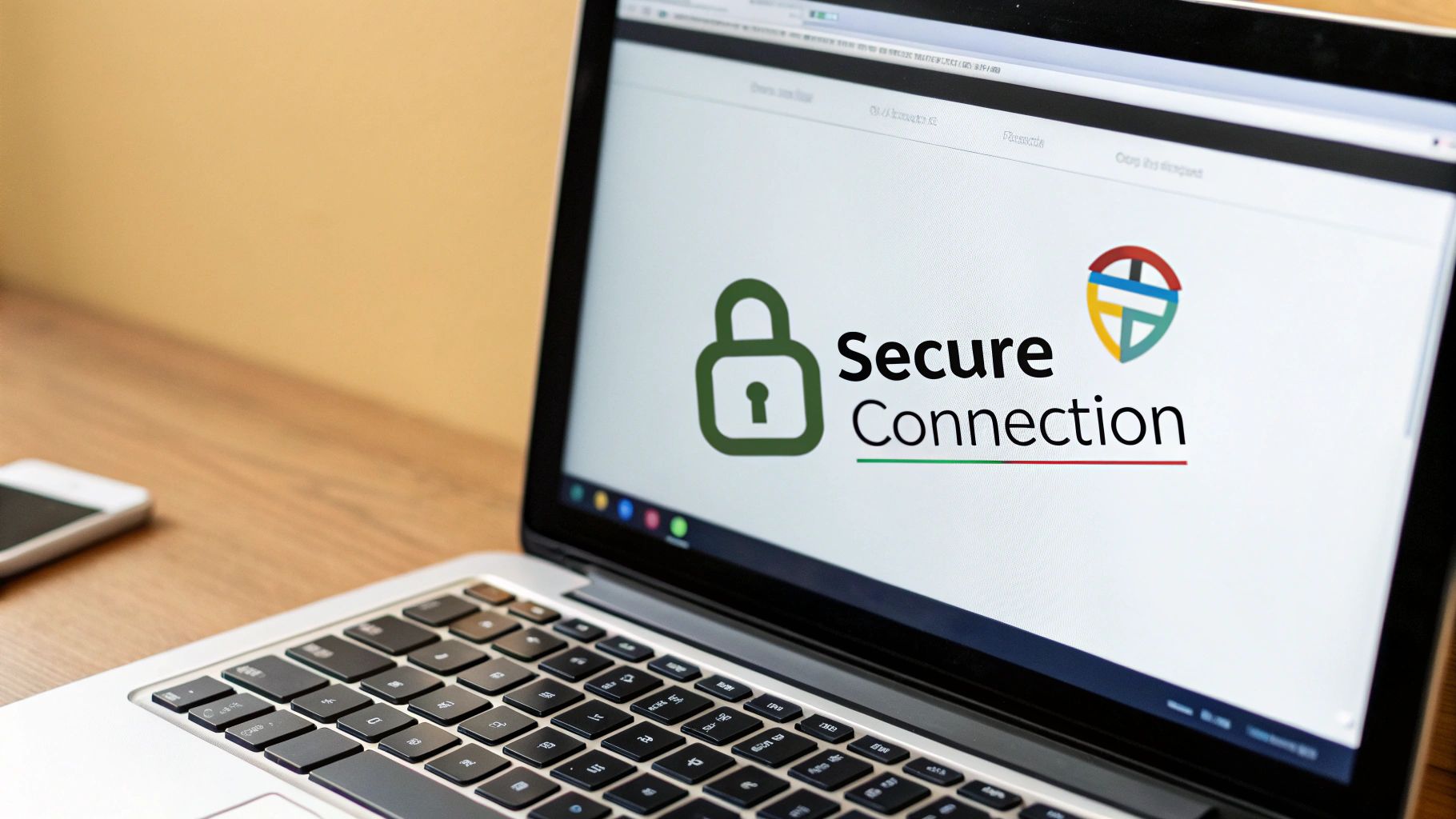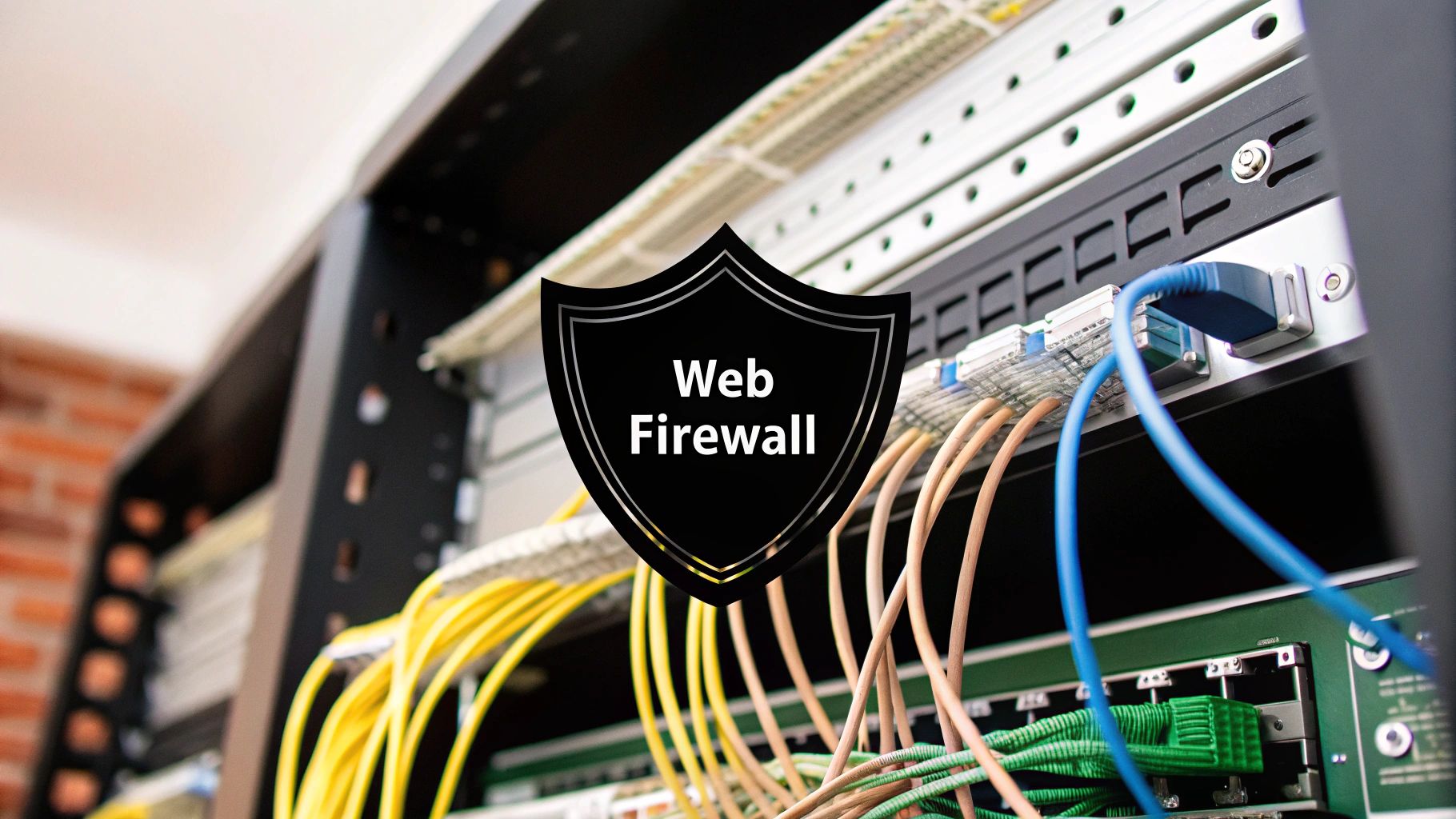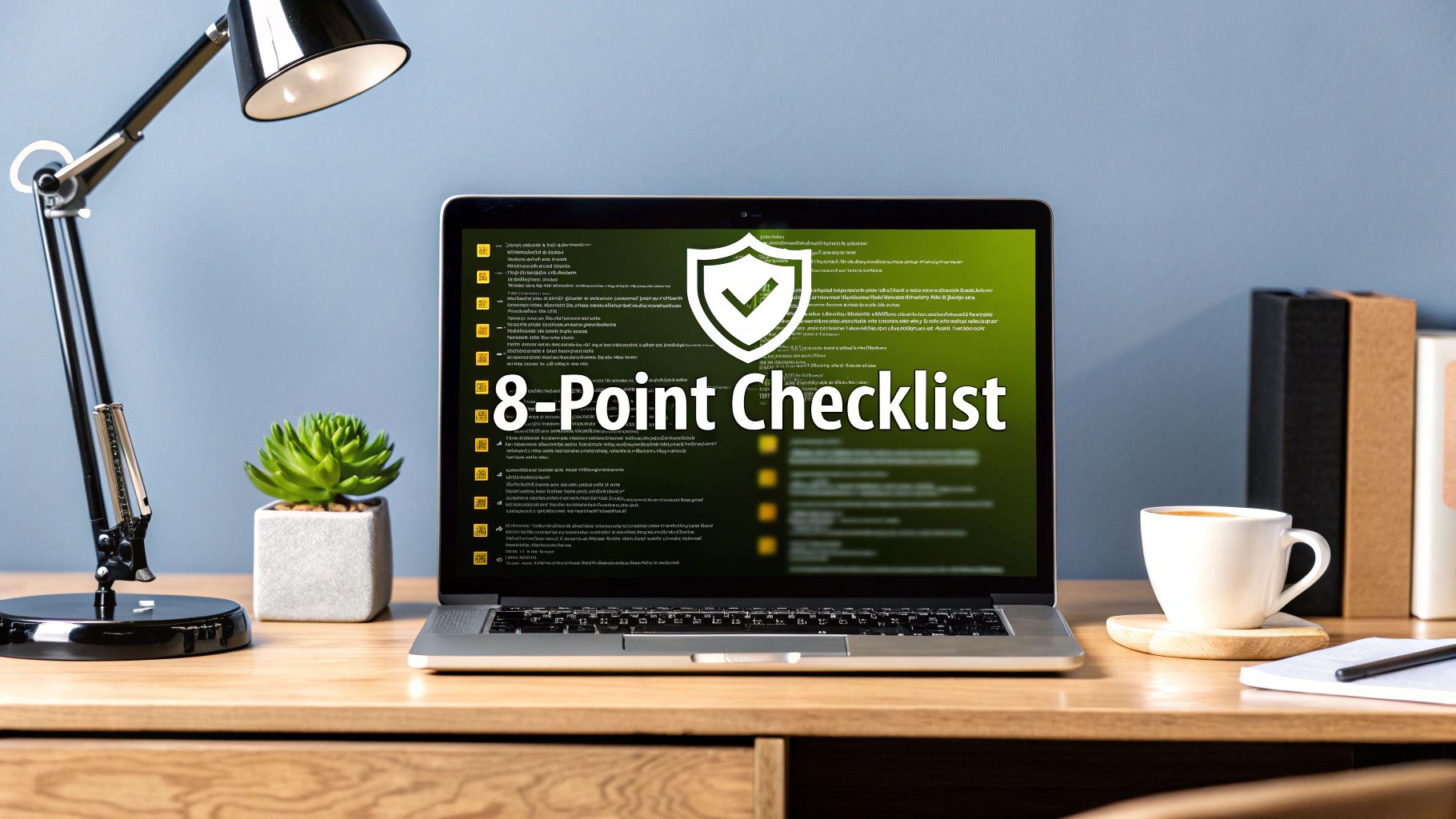In an era of relentless digital threats, a basic firewall and a strong password are no longer enough. Cyber-attacks are more sophisticated than ever, targeting businesses of all sizes, from local Norfolk enterprises to global corporations. A single vulnerability can lead to devastating data breaches, financial loss, and irreparable damage to your reputation. This is where a proactive, structured approach becomes non-negotiable. This comprehensive website security checklist is designed not just as a set of recommendations, but as an actionable roadmap. It provides a detailed, step-by-step guide to fortifying your digital assets against the evolving threat landscape.
Whether you're managing a complex eCommerce platform or a portfolio site, these eight critical areas will help you build a resilient and secure online presence. For those using the world's most popular content management system, a platform-specific guide can be invaluable. To complement your overall strategy, consider a focused WordPress security checklist to address its unique architecture. By systematically implementing the security measures outlined here, you can safeguard your business, protect your customer data, and maintain the trust you've worked so hard to build. Let’s dive into the essential tasks required to modernise your defences.
1. SSL/TLS Certificate Implementation
An SSL/TLS certificate is the cornerstone of modern website security, encrypting the data transmitted between a user's browser and your web server. This encryption prevents cybercriminals from intercepting and reading sensitive information, such as login credentials, personal details, and payment information. For any business operating online, especially eCommerce sites, a properly configured SSL/TLS certificate is a non-negotiable part of a robust website security checklist, signalling trust and professionalism to your visitors.

This security protocol, visible as "https" in the URL and a padlock icon in the browser's address bar, is not just a best practice; it is a fundamental requirement. Major search engines like Google actively prioritise secure websites, meaning a lack of SSL/TLS can negatively impact your search rankings and deter potential customers.
Why SSL/TLS is Essential
Implementing SSL/TLS is crucial for building user trust and protecting data. When customers see the padlock, they know their connection is secure, making them more likely to complete purchases or submit forms. It’s also a key defence against man-in-the-middle attacks, where an attacker secretly intercepts and alters communications between two parties. Modern implementations should use the latest protocol, TLS 1.3, for optimal security and performance.
Actionable Implementation Tips
To effectively implement SSL/TLS, go beyond basic installation. Follow these steps to maximise your site's security posture:
- Automate Certificate Renewal: Free certificates from providers like Let's Encrypt often have short lifespans (e.g., 90 days). Use automated renewal tools or services from your hosting provider to prevent your certificate from expiring, which would cause browser security warnings and disrupt service.
- Enforce HTTPS with HSTS: Implement the HTTP Strict Transport Security (HSTS) header. This tells browsers to only communicate with your server over HTTPS, preventing downgrade attacks that could force a connection back to an insecure HTTP.
- Configure Secure Cipher Suites: Ensure your server is configured to use strong, modern cipher suites and protocols (like TLS 1.3) while disabling older, vulnerable ones (like SSLv3 and early TLS versions).
- Regularly Test Your Configuration: Use a free tool like the Qualys SSL Labs Test to analyse your SSL/TLS configuration. It provides a detailed report and a grade (from A+ to F), highlighting any weaknesses that need addressing.
2. Strong Authentication and Access Control
While encryption protects data in transit, strong authentication and access control are your primary defences against unauthorised entry into your website's backend and administrative areas. These systems ensure that only legitimate users can access sensitive information and perform critical functions. For any business, establishing robust control over who can access your digital assets is a fundamental piece of a comprehensive website security checklist, preventing breaches that originate from compromised credentials.

This security layer goes beyond a simple username and password. It involves implementing multi-factor authentication (MFA), enforcing strong password policies, and assigning permissions based on the principle of least privilege. By layering these controls, you significantly raise the barrier for attackers, making it much harder for them to gain a foothold in your systems even if they manage to steal a password.
Why Authentication and Access Control are Essential
Implementing strong authentication is crucial for verifying user identities and preventing credential-stuffing attacks, where attackers use stolen passwords from other breaches. Role-based access control (RBAC) ensures that employees can only access the data and tools necessary for their jobs, minimising the potential damage from an internal mistake or a compromised account. For businesses using platforms like Microsoft 365, these controls are vital for safeguarding company-wide data. You can learn more about how to secure your business environment with Office 365 cyber security.
Actionable Implementation Tips
To effectively secure your access points, integrate multiple layers of authentication and management. Follow these steps to fortify your defences:
- Enforce Multi-Factor Authentication (MFA): Mandate the use of MFA for all administrative accounts. Use tools like Google Authenticator or security keys to add a second layer of verification beyond just a password, making unauthorised logins nearly impossible.
- Implement Strong Password Policies: Configure your system to require complex passwords (a mix of upper/lowercase letters, numbers, and symbols) and a minimum length. Encourage or enforce regular password updates and use tools to block common or previously breached passwords.
- Use Role-Based Access Control (RBAC): Define user roles with specific permissions. A content editor, for example, should not have access to server settings or user databases. This limits the "attack surface" if an account is compromised.
- Conduct Regular Access Reviews: Periodically review who has access to your systems. Remove permissions for former employees or users whose roles have changed, ensuring that access rights remain current and appropriate.
3. Regular Security Updates and Patch Management
Failing to update your website's software is like leaving your front door unlocked. Regular security updates and patch management involve systematically applying the latest fixes to all software components, from your core content management system (CMS) and plugins to server-side applications. This process is a critical part of any website security checklist, as it closes security holes that cybercriminals actively seek to exploit.
Software developers are constantly identifying and fixing vulnerabilities. A patch is a small piece of code released to fix a specific bug or security flaw. By neglecting these updates, you leave your website vulnerable to automated attacks that scan the web for outdated software. Maintaining a diligent update schedule ensures your digital assets are protected against the latest known threats.
Why Patch Management is Essential
A proactive patch management strategy is your primary defence against known exploits. It's a race against time; once a vulnerability is publicised, attackers immediately start trying to exploit it. Prompt updates for platforms like WordPress or server software like Apache are crucial for maintaining security, stability, and performance. This discipline is essential for preventing data breaches, service disruptions, and reputational damage.
Actionable Implementation Tips
An effective patch management process requires more than just clicking "update." Follow these steps to create a robust and reliable system:
- Establish a Testing Environment: Never apply updates directly to your live website. Use a staging or development environment to test patches first, ensuring they don’t break functionality or create new issues.
- Automate Where Possible: Utilise automated tools for critical security patches. Services like WordPress's automatic updates, GitHub’s Dependabot for code dependencies, or Ubuntu Livepatch can apply urgent fixes without manual intervention, reducing the window of vulnerability. For comprehensive support, you can learn more about expert WordPress maintenance services in the UK.
- Monitor Security Advisories: Subscribe to security mailing lists and advisories for all the software you use (e.g., WordPress security news, Drupal security releases). This keeps you informed about emerging threats and available patches.
- Create a Rollback Plan: Always have a procedure for rolling back an update if it causes problems. This involves having recent, reliable backups of both your website files and database before any changes are made.
4. Web Application Firewall (WAF) Configuration
A Web Application Firewall (WAF) acts as a critical shield, filtering and monitoring malicious HTTP traffic travelling between your website and the internet. It provides a powerful layer of defence against common cyber-attacks, such as SQL injection, cross-site scripting (XSS), and file inclusion, which are often used to compromise websites and steal data. For any business serious about its digital security, a properly configured WAF is an essential part of a comprehensive website security checklist.

Unlike a traditional network firewall, a WAF is specifically designed to understand and analyse web traffic at the application layer. This allows it to identify and block sophisticated threats that would otherwise go unnoticed, protecting your web applications from known vulnerabilities and zero-day exploits before they can cause damage.
Why a WAF is Essential
Implementing a WAF is a proactive security measure that significantly reduces your website's attack surface. It can virtually patch vulnerabilities in your code, giving your development team time to implement permanent fixes without leaving the site exposed. Services like Cloudflare WAF and AWS WAF offer robust, managed rulesets that are constantly updated to protect against emerging threats, providing peace of mind and resilient protection against automated bot attacks and targeted intrusion attempts.
Actionable Implementation Tips
To get the most out of your WAF, you must move beyond the default setup. Fine-tuning your configuration is key to maximising protection while minimising false positives that could block legitimate users.
- Start with Core Rulesets: Begin by enabling a reputable, pre-configured ruleset, such as the OWASP Core Rule Set. This provides a strong baseline of protection against the most common web vulnerabilities.
- Monitor and Tune Regularly: Initially, run the WAF in a monitoring-only mode to observe what traffic it would block. Analyse the logs to identify false positives and create custom rules to allow legitimate traffic, then switch to active blocking mode once you are confident in the configuration.
- Implement Rate Limiting: Configure rate limiting to prevent brute-force login attempts and mitigate the impact of denial-of-service (DDoS) attacks. This blocks IP addresses that make an excessive number of requests in a short period.
- Use Logging for Threat Analysis: Ensure your WAF is logging all blocked and monitored events. Regularly review these logs to understand the types of attacks targeting your site, identify patterns, and refine your security policies accordingly.
5. Input Validation and Sanitization
Failing to properly manage user-submitted data is one of the most common and dangerous security oversights. Input validation and sanitization is the practice of rigorously checking and cleaning all data that comes into your system from a user. This defensive measure prevents a wide range of injection attacks, such as SQL Injection and Cross-Site Scripting (XSS), where attackers insert malicious code into input fields to compromise your database or execute scripts in other users' browsers. This is a critical component of any comprehensive website security checklist.
Proper validation ensures that user input matches expected formats, types, and lengths before it is processed. Sanitization then strips out or neutralises any potentially harmful characters or code snippets. By treating all user input as untrustworthy by default, you create a powerful barrier against data corruption and unauthorised system access, protecting both your infrastructure and your users' data integrity.
Why Input Validation and Sanitization is Essential
Implementing robust validation and sanitization is fundamental for preventing the web's most prevalent vulnerabilities. It acts as a gatekeeper, ensuring that only safe and correctly formatted data reaches your application's logic or database. This is your first line of defence against attacks that exploit how your website handles incoming information. For example, without it, a simple comment form could become a gateway for an attacker to steal session cookies from your other visitors.
Actionable Implementation Tips
To effectively secure your website, you must apply validation and sanitization systematically across every user entry point.
- Validate on Both Client and Server-Side: Client-side validation (using JavaScript) provides a fast, user-friendly experience by catching errors before a form is submitted. However, it can be easily bypassed. Server-side validation is non-negotiable as it provides the actual security, re-checking all data in a controlled environment where an attacker cannot interfere.
- Use Parameterised Queries: When interacting with databases, always use parameterised queries (also known as prepared statements) instead of building SQL strings manually. This technique inherently separates the SQL command from the user-provided data, making SQL injection attacks impossible.
- Sanitise Output as Well as Input: It's equally important to sanitise data before it is displayed back to a user. This practice, known as output encoding, prevents stored XSS attacks where malicious scripts saved in your database are executed when rendered on a page. Libraries like HTML Purifier for PHP are excellent for this.
- Implement a Content Security Policy (CSP): A CSP is an added layer of security that helps to detect and mitigate certain types of attacks, including XSS and data injection. It's a browser-level instruction that tells it which dynamic resources are allowed to load, preventing the execution of malicious assets.
6. Data Backup and Recovery Planning
A comprehensive data backup and recovery plan is your ultimate safety net, ensuring business continuity after a security breach, hardware failure, or accidental data corruption. It involves more than just saving a copy of your files; it’s a strategic process for creating, storing, and testing backups to guarantee you can restore your website and its data quickly and reliably. For any business, from a local retailer in East Anglia to a national eCommerce platform, this plan is an indispensable part of a website security checklist.

Without a tested recovery strategy, even a minor incident like a faulty plugin update could lead to prolonged downtime, lost revenue, and damage to your reputation. Automated systems like AWS S3 with versioning or specialised services such as Veeam Backup & Replication provide robust solutions that protect against everything from ransomware attacks to simple human error, making them a critical investment.
Why Backup and Recovery is Essential
A solid backup strategy is the cornerstone of resilience. It allows you to quickly reverse the damage from a cyber-attack, restoring clean data and getting your operations back online with minimal disruption. This capability is crucial for maintaining customer trust and meeting your legal obligations under data protection regulations. A well-documented plan removes panic and guesswork during a crisis, enabling a swift and organised response.
Actionable Implementation Tips
To build a resilient backup and recovery system, your approach must be methodical and regularly verified. Follow these key steps:
- Adopt the 3-2-1 Backup Rule: Maintain at least three copies of your data on two different media types, with one copy stored off-site. For example, a local backup on a server, a second on a network-attached storage (NAS) device, and a third in a cloud service like Google Cloud Storage.
- Encrypt Your Backups: All backup data, whether in transit or at rest, should be encrypted. This prevents unauthorised access if your backup storage is compromised, adding another vital layer of security.
- Automate and Monitor: Use automated backup tools, such as those integrated into your UK-based web hosting or WordPress plugins, to ensure consistency. Crucially, set up alerts to monitor for backup failures so you can address them immediately.
- Test Your Recovery Procedures: A backup is useless if it cannot be restored. Regularly schedule and perform test recoveries to a staging environment. This verifies data integrity and ensures your team is familiar with the process, confirming you can meet your recovery time objectives (RTOs).
7. Security Monitoring and Incident Response
Effective website security is not a one-time setup; it requires continuous vigilance. Security monitoring and incident response involve the active observation of your website's activity, log analysis, and threat detection to identify and neutralise security incidents as they happen. This proactive stance ensures that any potential breach is addressed swiftly, minimising damage to your reputation, finances, and customer data. For any business, a well-defined response plan is a critical component of a comprehensive website security checklist.
This continuous process acts as your digital security guard, watching for suspicious behaviour around the clock. By leveraging tools like Security Information and Event Management (SIEM) systems, you can automate much of this process, receiving alerts for potential threats in real-time. This allows your team to move from a reactive to a proactive security posture, stopping attacks before they escalate into major crises.
Why Security Monitoring is Essential
Implementing a robust monitoring and response strategy is crucial for maintaining the integrity and availability of your website. It allows you to detect unauthorised access, malware infections, and other malicious activities promptly. A documented incident response plan ensures that when an alert is triggered, your team knows exactly what steps to take, reducing panic and ensuring a coordinated, effective reaction. This capability is fundamental for business continuity and building long-term trust with your audience.
Actionable Implementation Tips
To build an effective security monitoring and incident response framework, focus on these key actions:
- Establish Baseline Behaviour: Use tools like the ELK Stack (Elasticsearch, Logstash, Kibana) or Datadog to analyse and understand normal traffic and activity patterns on your website. This baseline makes it easier to spot anomalies that could indicate a security threat.
- Prioritise Critical Alerts: Configure your monitoring systems to distinguish between low-risk events and high-priority threats. Use tools like PagerDuty to ensure that critical alerts are immediately routed to the right personnel, preventing alert fatigue and focusing efforts where they matter most.
- Automate Common Responses: Where possible, automate responses to common, low-level threats. For instance, you can use a Web Application Firewall (WAF) to automatically block IP addresses that exhibit malicious behaviour, such as repeated failed login attempts.
- Conduct Regular Drill Exercises: Periodically run simulated security incidents, or drills, to test your incident response plan. This helps identify gaps in your procedures and ensures your team is prepared to act decisively during a real event. For more insights into creating robust security plans, you can learn more about our security services.
8. Security Headers and Content Security Policy
Beyond the foundational security of SSL/TLS, HTTP security headers offer a critical, browser-level defence mechanism. These headers are directives sent from your web server to a user's browser, instructing it on how to behave securely when handling your site's content. Implementing them correctly, especially a Content Security Policy (CSP), is a vital step in any modern website security checklist, significantly reducing the risk of common attacks like Cross-Site Scripting (XSS) and clickjacking.
A well-configured set of security headers acts like a set of rules for the browser, preventing it from executing malicious scripts or loading untrusted resources. A Content Security Policy, for instance, allows you to specify exactly which domains the browser should consider valid sources for scripts, styles, and other assets, effectively blocking unauthorised code injections.
Why Security Headers are Essential
Implementing security headers hardens your website against a range of client-side vulnerabilities. A CSP is particularly powerful against XSS, as it prevents the browser from executing inline scripts or loading scripts from malicious domains. Other headers, like X-Frame-Options or X-Content-Type-Options, provide crucial protection against clickjacking and MIME-type sniffing attacks, respectively. Organisations like GitHub and Google use robust CSPs as a core part of their security posture.
Actionable Implementation Tips
Getting started with security headers can seem complex, but a gradual approach makes it manageable. Follow these steps to fortify your website:
- Start with Report-Only Mode: Begin by implementing your Content Security Policy in
Content-Security-Policy-Report-Onlymode. This allows the browser to send reports of policy violations to a specified URL without actually blocking the resources, letting you identify and whitelist legitimate assets before enforcing the policy. - Use Generators and Scanners: Tools like Google's CSP Evaluator can help you analyse existing policies for weaknesses. For Node.js applications, frameworks like Helmet.js can set multiple security headers with sensible defaults, simplifying the initial setup.
- Gradually Tighten Policies: Don't try to create the perfect, most restrictive policy from day one. Start with a more permissive policy and incrementally tighten it as you analyse violation reports. This minimises the risk of breaking your site's functionality for legitimate users.
- Monitor and Test Regularly: Continuously monitor your CSP violation reports to catch new issues. Use a tool like the Mozilla Observatory to scan your site and get recommendations on which headers to implement or improve for a better security score.
Website Security Checklist Comparison
| Security Measure | Implementation Complexity 🔄 | Resource Requirements ⚡ | Expected Outcomes 📊 | Ideal Use Cases 💡 | Key Advantages ⭐ |
|---|---|---|---|---|---|
| SSL/TLS Certificate Implementation | Moderate – requires setup and management | Low to Moderate – certificate costs, renewal | Secure data in transit, user trust, SEO boost | Websites handling sensitive data or payments | Encrypts data, builds trust, SEO benefits |
| Strong Authentication & Access Control | High – complex setup and training | Moderate – MFA tools, training, backup plans | Reduced breach risk, granular access control | Systems needing strict access control and compliance | Strong breach prevention, audit trails |
| Regular Security Updates & Patch Management | Moderate – requires testing & scheduling | Moderate – time and testing resources | Fixes vulnerabilities, maintains stability | All software-based systems | Reduces attack surface, compliance |
| Web Application Firewall (WAF) Configuration | High – advanced rule setup and tuning | Moderate to High – ongoing maintenance | Blocks attacks, real-time protection | Public-facing web apps exposed to internet threats | Real-time defense, customizable rules |
| Input Validation and Sanitization | Moderate – development and ongoing upkeep | Low to Moderate – dev time, testing | Prevents injections, ensures data integrity | Applications accepting user input | Prevents injection, improves reliability |
| Data Backup and Recovery Planning | Moderate – setup automation & testing | Moderate – storage, bandwidth, management | Data protection, quick recovery | Any critical data environment | Protects data loss, reduces downtime |
| Security Monitoring & Incident Response | High – continuous monitoring, skilled staff | High – tools, personnel, alert management | Early threat detection, rapid response | Organizations needing proactive security | Early detection, forensic analysis |
| Security Headers & Content Security Policy | Low to Moderate – policy creation and testing | Low – mainly configuration | Prevents XSS, clickjacking, enforces policies | Websites seeking additional browser-layer security | Easy implementation, granular browser control |
From Checklist to Continuous Security Culture
Navigating the extensive website security checklist we have detailed is a monumental achievement. You have moved beyond generic advice and now possess a concrete, actionable framework for fortifying your digital presence. From the foundational necessity of SSL/TLS certificates and robust authentication protocols to the proactive defence mechanisms of a Web Application Firewall (WAF) and diligent patch management, each point on this list represents a critical layer of protection. We've explored how seemingly technical details, like configuring security headers or implementing rigorous input validation, are not just for developers but are essential business practices that safeguard your data, reputation, and revenue.
However, the most significant takeaway is that security is not a static, one-time task. A checklist, once completed, can quickly become outdated. The digital landscape is in constant flux, with new threats emerging daily. Therefore, the ultimate goal is to transition from simply completing a checklist to fostering a continuous, dynamic security culture within your organisation. This means transforming these actions into ongoing habits.
Key Pillars for an Enduring Security Posture
To make this transition successful, focus on integrating these core principles into your operational DNA:
- Vigilance as a Standard: Regular security updates, consistent monitoring, and periodic reviews of your access controls should not be extraordinary events. They must become as routine as balancing your accounts. Schedule these tasks and assign clear ownership to ensure they are never overlooked.
- Proactive Defence, Not Reactive Repair: Waiting for a breach to happen is a costly strategy. Implementing a WAF and a comprehensive data backup and recovery plan are proactive measures. They are your digital insurance policy, preparing you for the worst-case scenario while actively working to prevent it.
- Education and Empowerment: Your team is your first line of defence. Fostering a security-conscious culture involves training your staff to recognise phishing attempts, understand the importance of strong passwords, and report suspicious activity. An informed team is an empowered one, turning potential vulnerabilities into human firewalls.
By treating this website security checklist as a foundational blueprint rather than a final destination, you build more than just a secure website; you build a resilient business. The value extends far beyond preventing data loss. A demonstrably secure platform builds trust with your customers, enhances your brand’s reputation, and provides a stable foundation for growth. It signals to everyone, from clients in East Anglia to partners across the globe, that you are a reliable and professional organisation committed to excellence and integrity. This commitment is the true cornerstone of long-term digital success.
Feeling overwhelmed by the technical demands of a comprehensive website security checklist? The experts at Ibertech Solutions Limited can help. We provide bespoke, secure web design, reliable UK-based hosting, and ongoing IT support to businesses across Norfolk, Suffolk, and beyond, transforming security complexities into peace of mind. Contact Ibertech Solutions Limited today to fortify your digital assets with professional guidance.





